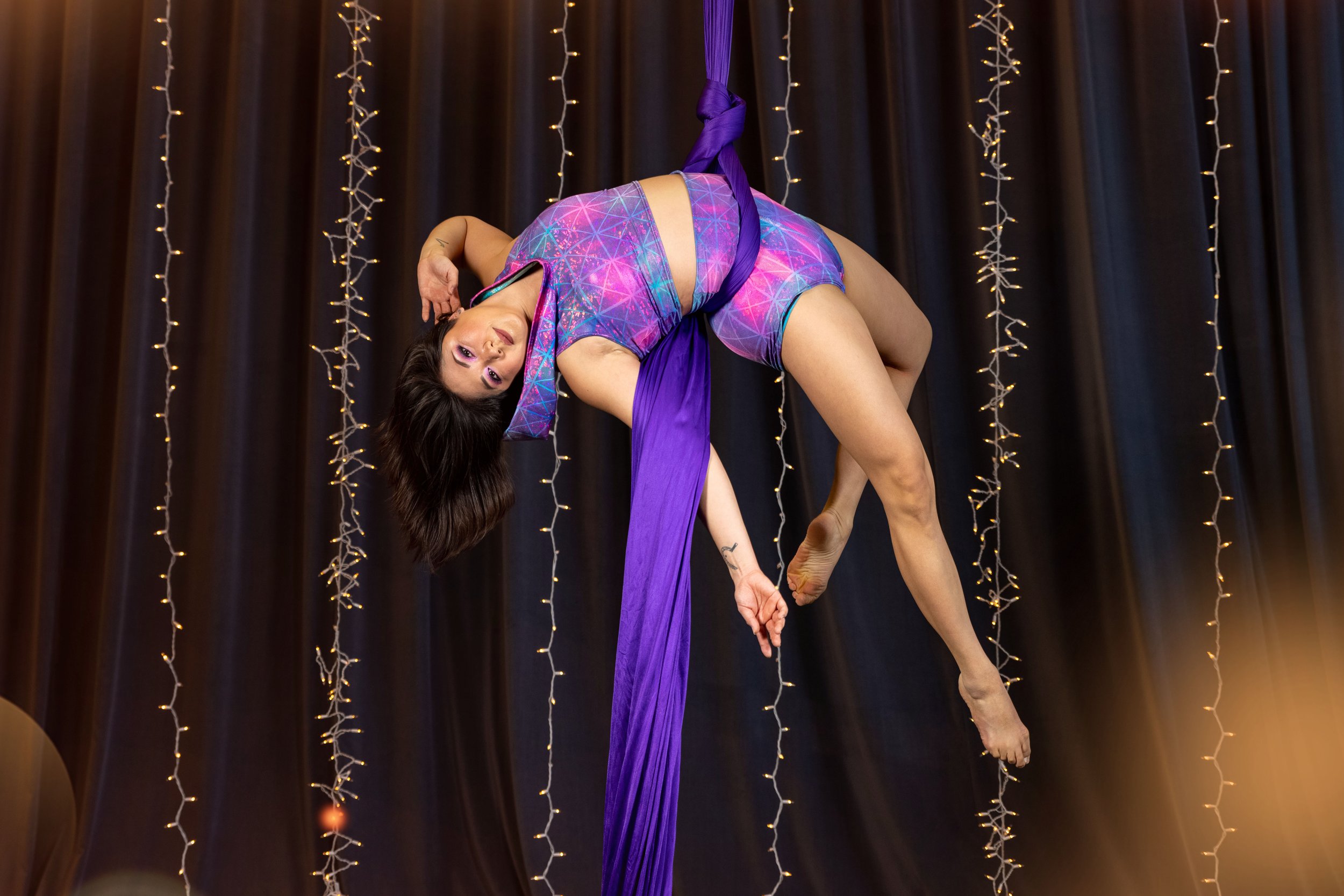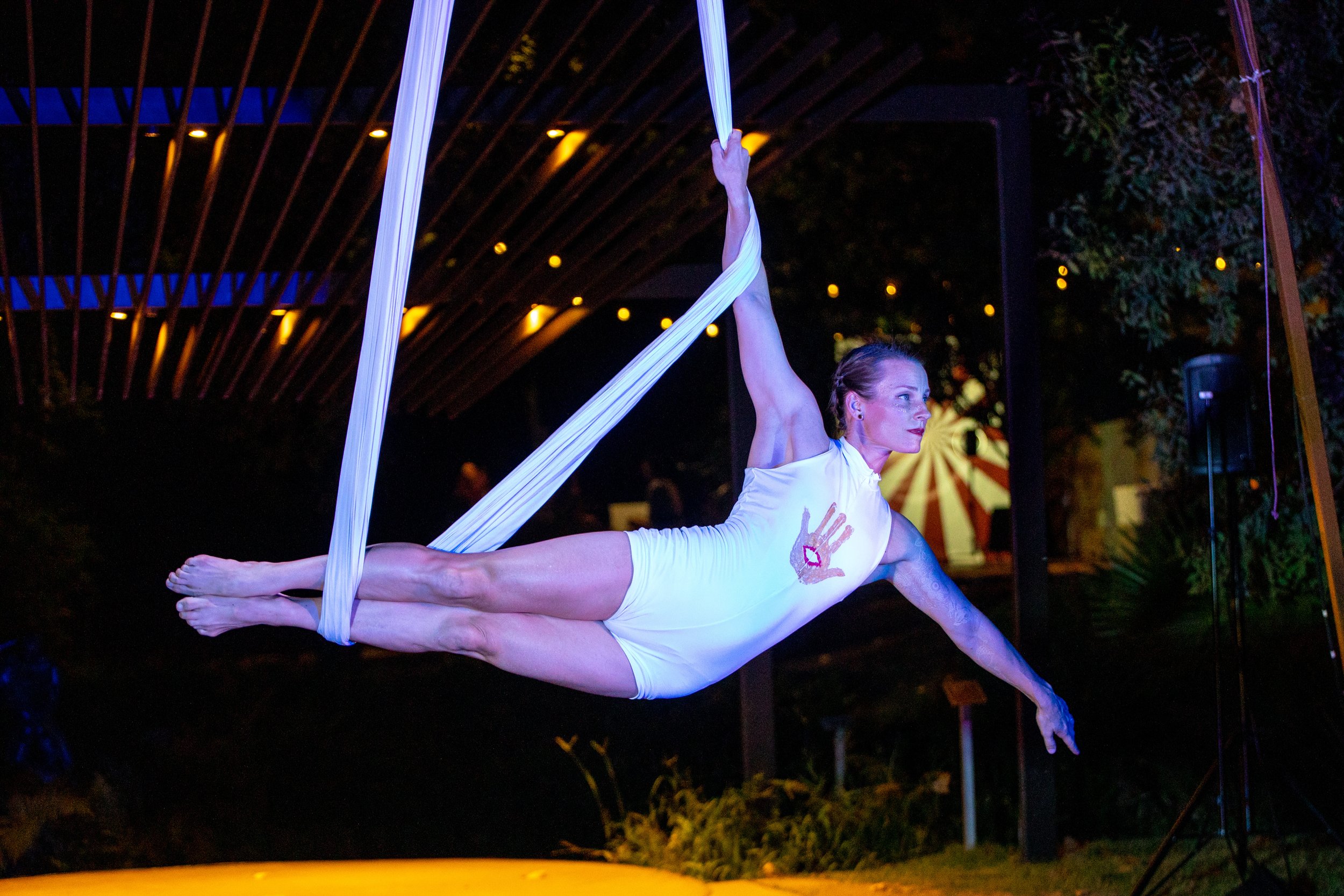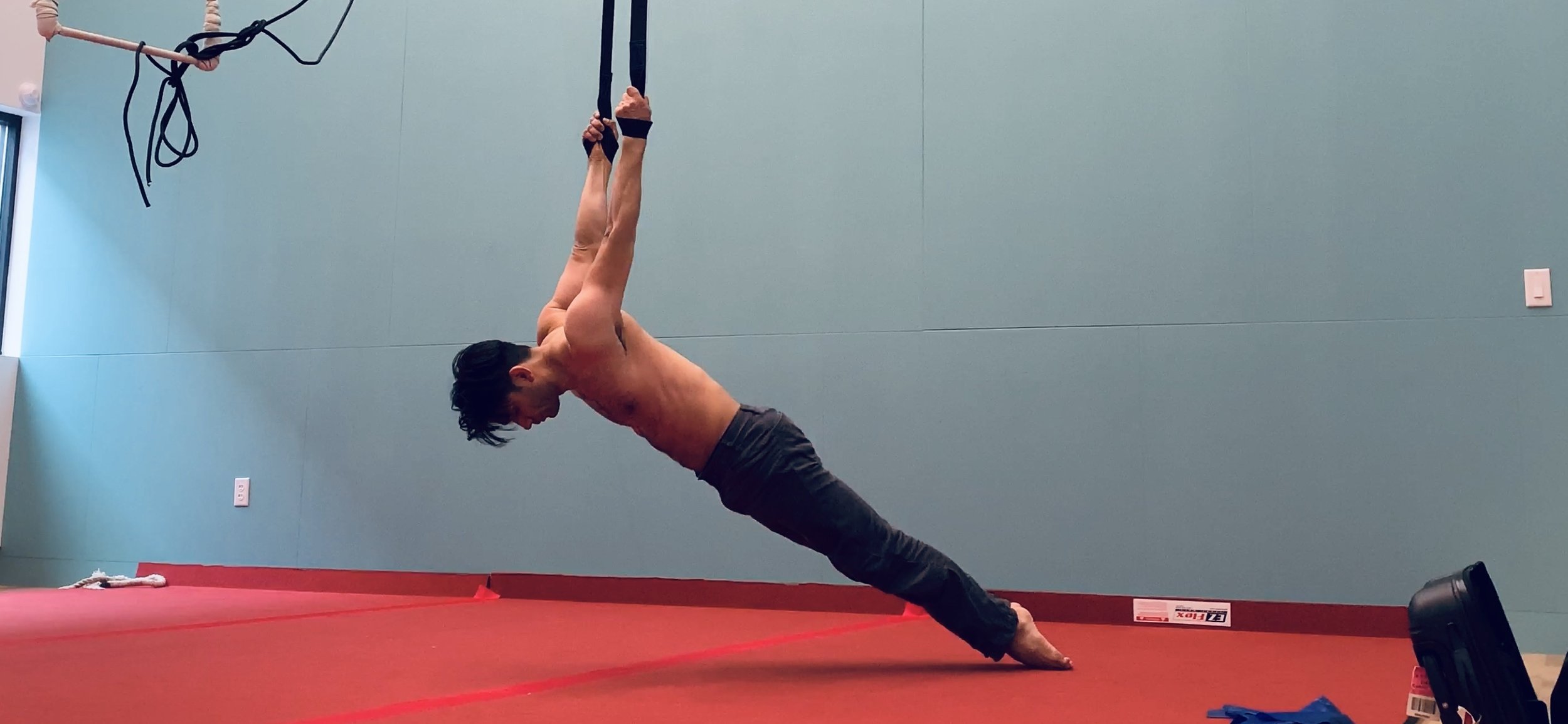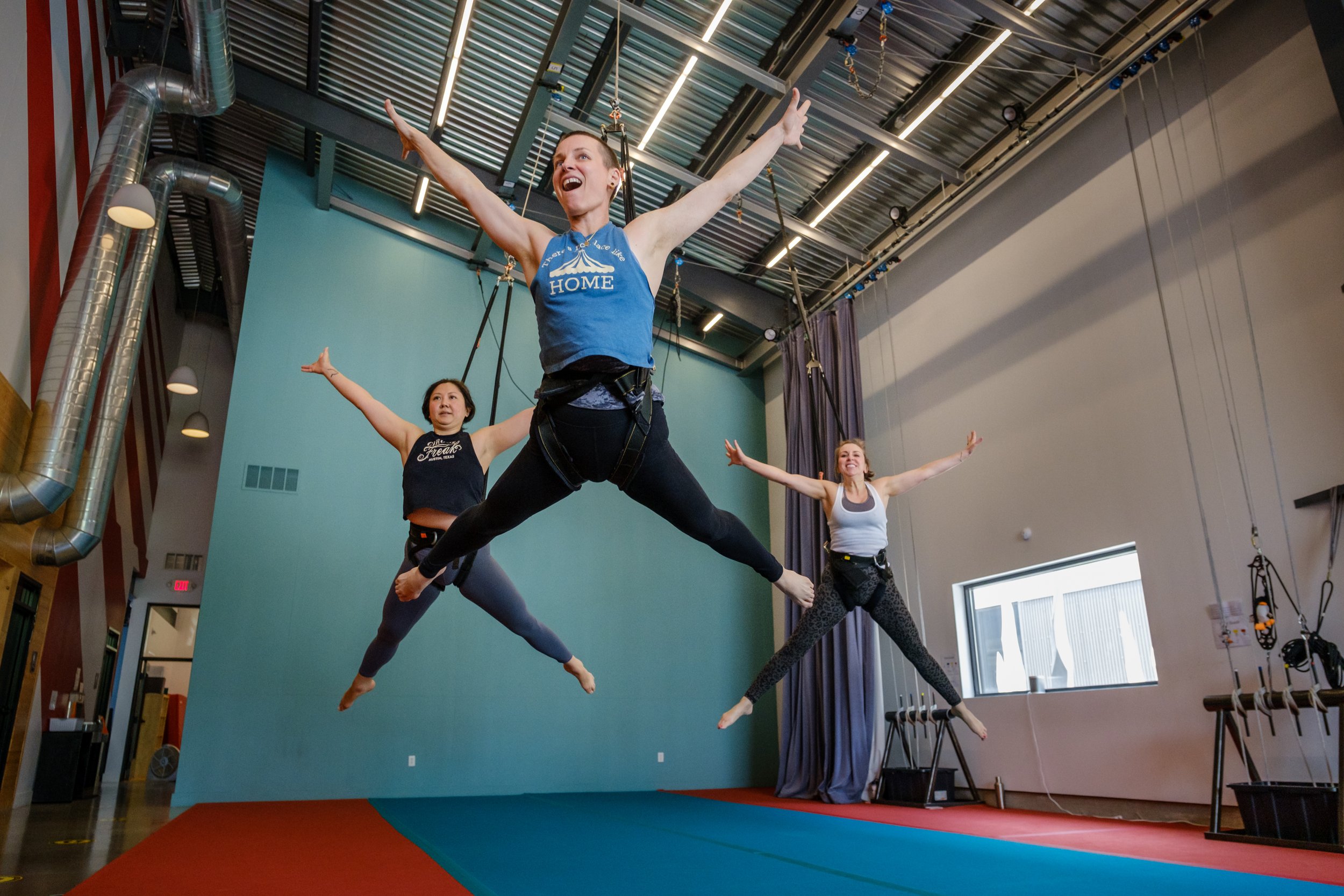
Apparatus, Levels, and Prerequisites
Are you new to aerial and circus arts and wondering what everything is? You’ve come to the right place!
Are you a current student who wants to understand the prerequisites to level up? You’re also in the right place!
Are you a new-to-Sky-Candy, but experienced aerial student wanting to know where to start? You’re also in the right place!
Many of your other questions are probably answered in the FAQ on our Getting Started page. If you have another question, please don’t hesitate to reach out to our team via our About Us page or the info at the very bottom of this page.
Here at Sky Candy, we believe that circus is for every body. We welcome students of all backgrounds to join the Beginner level of any apparatus (with just a few exceptions for some of our more challenging apparatus). We’ve put together this page to give you one easy spot to learn about all of the different apparatus and disciplines we teach, our leveling system, and class prerequisites. This page covers many of the apparatus and disciplines we teach including aerial silks, lyra, sling, trapeze, pole, flying pole, rope, straps, bungee, harness, tumbling, and handstands, but there’s also other disciplines like burlesque, dance, pilates, flexibility, and more that we offer regular classes in that are open to students of all levels here at our lovely east Austin studio!
Silks
Silks (also known as aerial silks, fabric, or tissu) is one of the most popular aerial apparatus. Silks hang in two long strands from a single point in the ceiling and students will learn how to climb, wrap, suspend, and drop as they build core and upper body strength developing their skills. This apparatus is great for folks who enjoy puzzles and problem solving!
-
Prerequisites
No prerequisites to enter
Goals
Climb and descend the apparatus comfortably using basic techniques
Learn footlocks and footlock shapes on the ground and begin executing those skills in the air
Learn and master short arm inversions on the ground and begin executing those skills in the air
Learn the mechanics of supported inverted skills using knee hooks, lever action, and wraps
Learn basic pathways to S and U wraps
Get comfortable with fundamental positions and shapes, including gazelle, straddle, arabesque, hipkey, front balance, crucifix, crochet, and more
-
Prerequisites
10 second long and short arm hang with hollow body
Russian and standard climbs - able to climb 16 ft.
Single and double footlocks in the air (figure 8 and aerial dance)
Footlock roll-ups and arrow
Split pole (tuck & straddle/frog) and single pole inversions (straddle/frog) from the ground
Inversion in the air (tagging okay)
10 second inverted straddle hold with poles together and with poles apart
Hip key from Russian lean
Clear understanding of same side and opposite side knee hooks
Single same side knee hook climb & exit
Controlled catcher’s descent
S Lock from catcher’s keyover / shoofly
Cross catcher’s → U Lock
Endurance in the air (1 minute)
Goals
Learn closed wrap drops & dives that move through space forwards, backwards, sideways, and down
Develop and apply understanding of S & U wrap theory and its accompanying movements
Develop and apply understanding of outside knee hook family and its accompanying movements
Learn rotational movements around a fixed point, including windmill, BBQ/legocopter, J-flip, etc
Develop endurance for executing multiple inversions in the air and sequencing familiar skills
Introduce C shaping, including specific work on back balance skills
Work on more advanced conditioning drills for skills such straight leg fankick hipkey, one arm hang, flags, meathooks, and skin the cat
Introduce beats and build long arm inversion strength
Learn skills with more complex entry and exit options, including belay
-
Prerequisites
Crossback straddle
Any entry to belay
Windmill (frog is okay)
Single star
Salto
Back balance (controlled entry, hand spot okay)
Endurance in the air (3 minutes)
BBQ / legocopter / single thigh rotations
Consistently clean straight leg inversions in air throughout class
Fankick hipkey
Multiple inversion knee hook climb
360 Drops (forward and backwards)
Goals
Expand on existing drop vocabulary to learn more complex and challenging wrapped drop variations, drops that change direction while falling, dynamic drops, and open drops
Explore skills that utilize meathook and skin the cat pathways
Learn more complex, dynamic pathways to familiar skills
Apply beats to dynamic skills and transitions and C shaping to rollups
Develop endurance for longer sequences of more advanced skills
Apply aerial theory to finding new pathways into familiar skills
Develop and apply understanding of inside knee hook family and its accompanying movements
Lyra
Lyra (also known as aerial hoop) is a metal apparatus (generally made from solid or tube steel). We have lyras in a wide variety of sizes to fit students of all heights, shapes, and abilities. Students learn how to invert, spin, pose, and transition as they core and upper body strength. This is a great apparatus for folks who love to spin!
-
Prerequisites
No prerequisites to enter
Goals
Build strength and comfort in hanging positions
Enter the lyra unassisted
Master foundational skills in and below the hoop
Move safely into and out of a hip hang
Demonstrate the basics of knee beats
Demonstrate control of the lyra during mounting and exiting
Familiarity with spinning
-
Prerequisites
Side entrance
Straddle entrance (tag okay)
Knee beats
Pike under the bar (top or bottom)
Gazelle
Mermaid
Transition into and out of hip drape
Wineglass
Dragonfly
Front balance (hands on okay)
Straddleback
Top bar knee hang and safe exit
Goals
Build strength in short arm positions, inversions, balances, and skills with one point of contact
Learn dynamic movements: beats, rolls, and small drops
Learn to use beats for dynamic skills and transitions
Build spin tolerance
Learn technique and build strength in long arm inversions and flares
Begin to sequence skills together and build endurance
-
Prerequisites
Straddle inversion and hold
Pullover
Front Balance (hands free)
Ankle Hang
Back Balance (hands free)
Amazon
Skin the Cat
Sitting → Single Hip Hang
Beat to sit
Single Arm, Elbow, and Knee Hang
Flag
A drop of student’s choice
Long beats and pike beats
Two skills that fully rotate around the bar, including front hip circle, back hip circle, Russian roll, mill circle
Able to invert the hoop
Beat to top bar hip drape
Goals
Learn advanced hangs, balances, and half and full release skills
Expand repertoire of dynamic skills and rolls
Develop endurance for longer sequences of more advanced skills\
Increase spin tolerance and strength in long arm inversions
Sling
Sling (also known as aerial hammock) is a loop of fabric with endless possibilities! For new-to-aerial students, sling is an accessible starting point to begin your journey and for more experienced students, sling offers a huge variety of movement opportunities that may feel familiar to skills you’ve worked on in silks, lyra, or trapeze. This is a great apparatus to start or deepen your aerial journey!
-
Prerequisites
No prerequisites to enter
Goals
Learn inversions from the ground
Learn foundational positions and their facets, including straddleback, horse, knee hooks, front balance, hipkey, catcher’s, seatbelt, and how to transition in and out of them
Develop standing skill vocabulary
Explore open sling shapes and skills
Introduce and develop comfort with simple dives and drops (forward dives, pops)
Introduce dynamic movement (knee beats, crucifix beats)
Sequence basic skills
-
Prerequisites
Short arm straddle and tuck inversions from standing on the ground
Knee beat
Pullover to front balance
Catcher’s
Hipkey
Arabesque on single pole
Triangle
Single leg roll up
Catcher’s dive of choice
Seatbelt entrance of choice
Sequence 5 skills of student’s choice in a row
Goals
Introduce relational theory (how skills transitions between each other, for example with catcher’s, seatbelt, and hip/thigh corsets)
Learn more simple drops and dives that move backwards, sideways, and straight down through space
Introduce C shaping, including specific work on back balance skills
Continue work on beats and learn new pathways
Learn rotational movements around a fixed point, including BBQ, J-flip, etc
Master aerial inversions and develop skills in the poles/ropes
Work on more advanced conditioning drills for skills such one arm hang, flags, meathooks, and skin the cat
-
Prerequisites
Clean aerial inversion (tuck and straddle) throughout class
Forward, pike, and bell beats
Hip corset entrance of choice
Thigh corset entrance of choice
Slow BBQ/rotisserie
Crossback straddle
Horse arounds / beauty rolls in both directions
Scissor roll
Back dive
Sideways moving drop/dive of choice (hipkey, secretary, peter pan, cartwheel)
Endurance in the air (3 minutes)
Goals
Continue working on skills in the poles/ropes
Apply C shaping and dynamic movement in familiar skills and new pathways
Expand on existing drop vocabulary to learn more complex and challenging wrapped drop variations, drops that change direction while falling, dynamic drops, and open drops
Develop long arm inversion strength
Experiment with more challenging variations and longer sequences using previously established skills
Expand repertoire of dynamic skills and rolls, including new beat variations
Trapeze
Trapeze (also known as static trapeze) is one of the most iconic aerial apparatus. Made up of two ropes and a steel bar, this apparatus is beautifully versatile with accessible skills for new students and challenging dynamic movements for experienced students. Part “soft apparatus” and part “hard apparatus”, trapeze is a great apparatus if you want to explore aerial movements where you move around your apparatus and where your apparatus moves around you!
-
Prerequisites
No prerequisites to enter
Goals
Find ease and balance in, into, and out of neutral positions (long arm hang, sit, stand, hip drape, knee hang)
Learn and master foundational positions and their facets/points of contact, including gazelle, mermaid, coffin, hip drape, straddle back, knee hang, bat hang, and how to transition in and out of them
Discover pathways through rotations (sit to hips/hips to sit)
Master foundational skills on and below the bar
Learn the basics of momentum skills, including long, pike, and knee beats
Learn how to independently get to high bar (rope climb, jump, etc)
While this class is mostly taught on static trapeze, we will also introduce single-point trapeze.
-
Prerequisites
Able to invert without assistance through a pullover and a tuck or a straddle
Knee beats
Gazelle
Mermaid
Transition into and out of hip drape (via rotation)
Dragonfly
Front balance
Straddleback
Bat hang
Standing side balance
Arabesque
Lijanna
Ankle hang with spotting rope
Able to safely get onto a high bar without assistance
Beginner Up/Down: Tuck or straddle onto bar, rock n’ roll to sit, perch to stand, stand on demi-pointe, return perch, straddle/trashcan exit, straddle out
Goals
Develop transitions above/below bar
Continue work on beats, learn new pathways and learn to use beats for dynamic skills and transitions
Introduce more dynamic movements including rolls/rotations, slides, and small drops
Build strength in short arm positions, inversions, balances, and skills with one point of contact
Begin to sequence skills together and build endurance
Introduce relational theory (how skills transitions between each other)
Master aerial inversions and develop skills in the ropes
Work on more advanced conditioning drills for skills such toe hangs, heel hangs, single knee hang, one arm hang, meathooks, and skin the cat
-
Prerequisites
Aerial inversion (straddle and tuck)
Single crochet (both sides)
Ankle hang
Single knee hang (both sides)
Long and pike beats
Single arm hang (both sides)
Crucifix
Skin the cat
Intermediate Up/Down: Pullover on the bar to hip drape to front balance to no hand drop to catcher’s to straddle to knee beat to pop to sit to ankles to long arm straddle down
Goals
Learn advanced hangs, balances, and half and full release skills
Expand repertoire of dynamic skills and rolls and drops
Develop endurance for longer sequences of more advanced skills
Develop strength in long arm inversions
Explore more skills in the ropes
Learn and apply C shaping
Develop a personalized vocabulary of transitions and shapes
Rope
Rope (also known as corde lisse) is an elegant aerial apparatus. Utilizing similar techniques to silks, rope provides endless possibilities for dynamic movement and static poses that at once seem impossible and deceptively simple. We generally recommend that students start with silks to get their bearings before transitioning to rope, but those who do often find their love of their apparatus in its clean movement. This apparatus is recommended for students with some silks experience who want to further explore!
-
Prerequisites
No prerequisites to enter
Goals
Climb and descend the apparatus comfortably using basic techniques
Learn footlocks and footlock shapes on the ground and begin executing those skills in the air
Learn and master short arm inversions on the ground and begin executing those skills in the air
Learn the mechanics of supported inverted skills using knee hooks, lever action, and wraps
Learn basic pathways to S and U wraps
Get comfortable with fundamental positions and shapes, including gazelle, straddle, arabesque, hipkey, front balance, crucifix, crochet, and more
Introduce dynamic movement with bell and front pike beats
-
Prerequisites
10 second long and short arm hang with hollow body
Russian and standard climbs - able to climb 16 ft.
Single footlocks in the air (figure 8 and aerial dance)
Footlock arrow
Single pole inversions (straddle/frog) from the ground
Inversion in the air (tagging okay)
Hip key from Russian lean
Clear understanding of same side and opposite side knee hooks
Single same side knee hook climb & exit
Controlled catcher’s descent
S Lock from catcher’s keyover / shoofly
Cross catcher’s → U Lock
Endurance in the air (1 minute)
Familiar bell and front pike beats
Goals
Learn closed wrap drops & dives that move through space forwards, backwards, sideways, and down
Develop and apply understanding of S & U wrap theory and its accompanying movements
Develop and apply understanding of outside knee hook family and its accompanying movements
Learn rotational movements around a fixed point, including windmill, BBQ/legocopter, J-flip, etc
Develop endurance for executing multiple inversions in the air and sequencing familiar skills
Introduce C shaping, including specific work on back balance skills
Work on more advanced conditioning drills for skills such straight leg fankick hipkey, one arm hang, flags, meathooks, and skin the cat
Develop and apply understanding of inside knee hook family and its accompanying movements
-
Prerequisites
Windmill (frog is okay)
Single star
Salto
Back balance (controlled entry, hand spot okay)
Endurance in the air (3 minutes)
BBQ / legocopter / single thigh rotations
Consistently clean straight leg inversions in air throughout class
Fankick hipkey
Multiple inversion knee hook climb
Consistent beat to inversion, pike turn beat, scissor beat
Goals
Expand on existing drop vocabulary to learn more complex and challenging wrapped drop variations, drops that change direction while falling, dynamic drops, and open drops
Explore skills that utilize meathook pathway
Learn more complex, dynamic pathways to familiar skills
Apply beats to dynamic skills and transitions and C shaping to rollups
Develop endurance for longer sequences of more advanced skills
Apply aerial theory to finding new pathways into familiar skills
Pole
Pole (also known as pole dancing) combines dance and acrobatics on a vertical pole. Pole as a movement art has diverse origins from the Indian sport of mallakhamb to acrobatic Chinese pole to American sideshows and striptease. This is a great apparatus for students looking to get in touch with their sensual side with a challenging apparatus that combines a full body strength, flexibility, and coordination workout!
-
Prerequisites
No prerequisites to enter
Goals
Gain confidence moving on the floor with the pole
Learn to climb the pole and invert from the floor
Learn how to spin on both static and spin pole
Build spin tolerance
Become accustomed to the sensations of the pole on the inner thighs
Learn to sequence skills on and off the pole
-
Prerequisites
Basic climb
Basic pole sit and wrist sit
Figure 4 layback
Firefighter spin, front and back knee hook spin, chair spin
Fan kick
Headstand or handstand
Inversion from ground, tagging acceptable
Inverted crucifix, hands off the floor
Jasmine, from the floor
Goals
Build strength for aerial inversions
Continue sequencing skills on and off the pole
Learn inverted skills with at least 3 points of contact
Introduce and build strength towards shoulder mount
Learn to switch your torso from one side of pole to the other
Develop endurance for sequences of skills on the pole and increase spin tolerance
-
Description text goes here
Straps
Straps (also known as aerial straps) is arguably the most demanding aerial apparatus we offer. New skills take most students months to achieve, let alone master, but with unwavering determination, you too can achieve seemingly impossible movements on the straps. This apparatus is not for the faint of heart and is an excellent choice for those with stubborn resolve and dedication to consistency.
-
Prerequisites
Comfortable with bent arm inversions
Working on straight arm inversions
2 or more pullups
3 or more skin the cats
Goals
Develop proper meat hook position
Strengthen long arm and one arm technique
Introduce and work on flag prep progressions
Integrate spins into skills
Harness
Harness (also known as harness dance, wall running, or wall dancing) is an art form you may be familiar with seeing on the sides of buildings here in Austin. Suspended in the air with a climbing harness and rope, students get to explore movements with a wall and in open space, challenging their core strength, balance, and coordination. This apparatus is great for folks who want to take their dance practice and turn it sideways!
-
Prerequisites
No prerequisites to enter
Goals
Learn safe use of equipment
Become comfortable moving between planes
Build core stability and awareness
Navigate moving on the wall with another person
-
Prerequisites
Can safely and independently use equipment
Comfortable moving on the wall with a second person
Familiar with all beginner material, including transitions
Mastery of any bat hang entrance and exit
Goals
As core strength and awareness continue to build, moving away from self-spotting with a hand on the rope
Maintain a horizontal position in all side-facing and supine skills
Build comfort with rotations away from the wall
-
Prerequisites
Mastery of rotating away from the wall
Solid understanding of the intermediate level skills and beginning to explore outside those skills
Goals
Pass through multiple orientations in jumps
Practice sequence building
Explore far point, open point, and duo
Bungee
Bungee is a high intensity and low impact workout that incorporates cardio, dance, low flying fun, and a lot of bouncing. If you’ve ever dreamed of flying through the air with the greatest of ease, bungee might just be your new favorite apparatus.
Our program is size inclusive and we can accommodate students with waists from 24” - 64” with our array of harness sizes.
-
Open to all students
-
Must have taken Intro to Bungee at least once
Handstands
Handstands (also known as hand balancing) is a circus discipline where practitioners support their body in a stable, inverted position on their hands. Balance, strength, flexibility, and coordination are all key elements to successfully finding your best inverted self on the ground. Handstands are excellent cross-training for all aerial apparatus as it they utilize your muscles in “push” strength versus “pull” strength. Handstands is a discipline that is excellent if you’re looking to get in touch with your body and the ground!
-
Prerequisites
An enthusiasm for pushing the ground away
Goals
Learn how to prepare for handstand training
Learn best drills for improving body alignment
Improve flexibility and shoulder strength
Learn how to safely enter and exit the wall (bail)
Develop confidence for kicking up into handstand
-
Prerequisites
Comfortable holding a 30 sec handstand with support against the wall
Can consistently kick up into a handstand against a wall and already has a solid cartwheel
Goals
Find balance, aiming for a consistent 5-10 second handstand
Begin doing handstands away from the wall
Develop more consistency when kicking up into a handstand hold
-
Prerequisites
Already have an established handstand practice, training on a regular basis throughout the week (preferably, at least 2-3 times a week)
Are able to hold a fairly consistent freestanding handstand for at least 10 seconds
Goals
Pressing into handstand (straddle, pike, stalder, puppy press)
More advanced shape change variations in 2 arm handstands
Shifting and side-bending in a handstand
And many other drills to help strengthen your mastery of the two arm handstand, and better prepare you for one arm handstand training
Tumbling
Intermediate Tumbling Prerequisite Skills video
Tumbling is a discipline that is part of gymnastics, cheer, circus arts, and dance. Tumbling involves executing of acrobatic movements such as rolls, twists, handsprings, or somersaults. Unlike many other things we teach, tumbling’s only apparatus is the floor!
Our tumbling program is focused on adult learners.
-
Prerequisites
None
Skills We Cover In This Level
Basic gymnastics shapes (tuck, straddle, pike)
Basic core shapes (hollow, side arch, tight arch, max tall)
Rolls forward and backward
Kicking up into handstand
How to bail from a handstand and how to fall safely from gymnastics
How to perform a cartwheel
Beginner Back and Front Walkover drills
Basic Jumps in Tuck, Straddle and Pike
-
Prerequisites
Comfortable holding a 30 sec handstand with support against the wall
Can consistently kick up into a handstand against a wall and already has a solid cartwheel
Comfortable hold a gymnastics bridge support for 30 secs on the floor
Skills We Cover In This Level
Front Walkover
Back Walkover
Dive Cartwheel and Aerial Cartwheel
Round offs
Intro to back handsprings
Intro to front handsprings
-
Prerequisites
Comfortable performing a front and back handspring
Comfortable performing a round off
Comfortable performing a dive roll onto mats
Comfortable performing a handstand hold for 5 or more seconds
Skills We Cover In This Level
Intro to back handspring series (2 or more)
Intro to front handspring series (2 or more)
Standing Back Salto
Punch Front Salto
Arabian Dive roll/ Salto
Basic Twisting drills
Advanced Tumbling Prerequiste Skills video
Flying Pole
Flying pole is the new hot apparatus in the aerial world. Using a silicone or stainless steel pole suspended in the air, flying pole creates an entirely new experience. It elevates pole skills and provides an intriguing challenge for students accustomed to more traditional aerial apparatus. Why not jump into something new today and see where it takes you?
-
Prerequisites
Successful completion of at least one full Beginner Pole series or teacher approval
Goals
Gain confidence moving on the floor with the pole
Learn to climb the pole and invert from the floor
Learn how to spin on both static and spin pole
Build spin tolerance
Become accustomed to the sensations of the pole on the inner thighs
Learn to sequence skills on and off the pole
-
Prerequisites
Inversion to knee hooks and crucifix from floor (tag okay)
10 sec bracket and long arm hang
Can sequence 5 skills with sway and orbit
Executes sway and orbit with control
Familiar with all Beginner Flying Pole material
About Class Levels
Classes at Sky Candy are all about progressions. Each class is designed around a number of core concepts, listed as “Goals” in the table below. These core concepts develop from one level to the next. In each 5-week or 10-week series, your teacher will work with you through a selection of skills, drills, and transitions from that level’s curriculum.
Series classes are split out into Beginner, Intermediate, and Advanced. For most apparatuses, Beginner classes have no prerequisites and are open to those with no experience. Our main notable exception is Straps, which is a more demanding apparatus that has requisite strength requirements to start due to its steep learning curve and its intense demands on the body.
It’s All About the Journey
It can be easy to see a list of levels as a ladder to climb as quickly as possible, but we encourage students to let go of expectations about how long it will take them to graduate from a level. Everyone moves at their own pace, and progress isn’t always linear. Students are welcome to move back to a previous level after taking a break, recovering from injury or illness, or just to refresh fundamental skills in a less advanced class.
We use the prerequisites listed below as a quick guide to what you’ll need in the next level, but your teacher always has the final say on when you advance.
Mastery And Why Is It Important
You’ll see that many prerequisites ask for “mastery” of particular skills. We define mastery as:
Ability to execute a skill independently
Without cues or demos (verbal or physical)
Without spotting
Solid form / technique
Safe entry and exit from the skill (not just getting to the skill at any cost)
Performed in a manner that is safe, efficient, and repeatable one’s body
Understanding and awareness of facets/points of contact and where your body is in space while executing skill
Why is skill mastery important for advancement?
Good form now opens up students to more easily transitioning to more advanced progressions
Minimizes risk of injury
Gives students the freedom to make aesthetic choices
Efficiency in movement ensures longevity in the activity
About Class Levels












